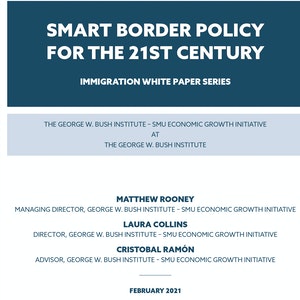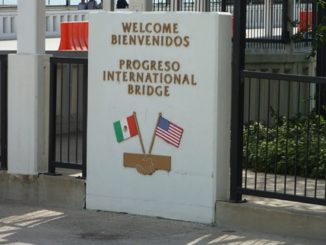
From migration to trade to security, policy solutions must recognize that today’s reality and tomorrow’s problems require a comprehensive solution to the border.
by Matthew Rooney and Laura Collins

The domestic political conversation on border policy in the United States has for too long been characterized by a very narrow definition of security – deterrence and physical barriers – that ignores many opportunities to better secure our perimeter.
From migration to trade to security, policy solutions must recognize that today’s reality and tomorrow’s problems require a comprehensive solution to the border. The United States must work in Central America to address the root causes of migration from El Salvador, Guatemala, and Honduras. We must work with Mexico to ensure it takes its own border security seriously. And we must upgrade our border infrastructure at ports of entry, increasing both efficiency and security when screening cargo and passengers alike.
To be sure, border security measures like physical barriers are useful and necessary between ports of entry along some portions of the southwest border. Congress recognizes this, having appropriated billions of dollars for building hundreds of miles of physical infrastructure over the last two decades, under both Republican and Democratic presidents. Where physical infrastructure is impractical, Congress should fund surveillance technology as an excellent substitute.
Furthermore, working with our neighbors to improve security across the region is a vital component of any policy to promote prosperity and rule of law in the hemisphere. A safe and secure region will lead to a safer, more secure United States.
This paper marks the George W. Bush Institute’s commitment to broadening the conversation about U.S. border policy that incorporates an “all of the above” approach to the border. Our recommendations were developed through a series of roundtable discussions with experts on immigration, trade, and law enforcement. They call on the United States to work with the governments of El Salvador, Guatemala, Honduras, and Mexico to adopt a flexible approach that addresses the intertwined challenges in the region, including the following:
- Formally incorporating the other regional governments into a law enforcement plan that’s feasible and consistent and includes security and non-security goals.
- An enforcement approach that combines positive and negative incentives to promote compliance with our immigration laws, including expanded legal immigration channels and in-region processing.
- Solutions to tackle corruption in the Northern Triangle, promote regional economic integration, strengthen border security, and upgrade infrastructure at ports of entry.
We do not need to sacrifice our humanity in the name of security. But we must be nimble in the face of changing circumstances and work closely across the entire region to prevent real security threats while upholding our tradition as a welcoming nation.
DEVELOPING A REGIONAL LAW ENFORCEMENT COOPERATION
Border security strategy that is primarily concerned with confronting threats and stopping migrants at the southwest border does not recognize the current challenges facing law enforcement. As the smuggling of people and illicit goods shows, criminal and security threats extend from the U.S.-Mexico border through the Northern Triangle. Law enforcement cooperation is critical among the five governments to tackle the myriad of existing and emerging security threats that undermine prosperity and rule of law in the region.
Growing law enforcement cooperation between the United States and the four other countries serves as the starting point for these efforts. The Mérida Initiative, for example, improved security cooperation between Mexico and the United States to address threats, strengthen the rule of law, and build resilient communities in both countries. The partner countries could sign an agreement that links the Mérida Initiative to the Central America Regional Security Initiative — which provides funding and training to Central American law enforcement agencies to promote public safety in the region. Alternatively, the United States and Mexico can incorporate El Salvador, Guatemala, and Honduras into a new security agreement.
The United States and Mexico could also encourage Canada to see regional security cooperation that provides Mexican law enforcement agencies with the resources to tackle security issues at the Mexico-Guatemala border as a contributor to Canada’s national security. One model for this effort is the 2011 U.S.-Canada Beyond the Border Initiative, which saw the two countries establish new programs and protocols to strengthen joint security cooperation at their shared border.
Regardless of the vehicle for promoting law enforcement cooperation in the region, this effort will require the the open sharing of information, so the countries should select agreed-upon vetting mechanisms to screening law enforcement partners. The El Paso Intelligence Center is a good model. The governments should build on this initiative and others that vet law enforcement agencies across the five countries targeting gangs and cartels and carrying out joint activities.
Finally, the scope of regional law enforcement activities should include security and non-security issues. For instance, the United States and Mexico can expand the scope and reach of the Mérida Initiative’s immigration component in the following ways:
- Professionalizing the immigration agencies in Mexico and the Northern Triangle countries.
- Improving the coordination of asylum processing in the region.
- Working with the Northern Triangle countries to improve their immigration enforcement efforts between ports of entry, especially for extracontinental migrants who do not have freedom of movement in the region.
The five countries must also address Mexico’s economic and security interests. This includes addressing the movement of firearms from the United States into Mexico and targeting migrant smugglers operating in Mexico and along its borders. Finally, these countries should support new United Nations and Organization of American States anticorruption initiatives to improve law enforcement capacities in the region.
BORDER METRICS
Consistent and feasible goals and metrics are needed. Although targeting illicit smuggling and unauthorized migration should remain the foundation for law enforcement activity at the U.S.-Mexico border, Congress and the executive branch should work with U.S. Customs & Border Protection and its law enforcement partners to set realistic targets for meeting these goals over time.
The five governments should also incorporate relevant law enforcement metrics into a comprehensive database available to all five countries. These states already engage in information sharing activities through initiatives such as the Transnational Anti-Gang Task Force. However, developing a unified platform over time would help coordinate law enforcement activities, especially in response to changes in migrant flows, which could indicate increased human trafficking or smuggling activities. To implement this plan, the states should create a vetting mechanism to ensure that the agencies and agents that access this information do not use it to undermine law enforcement.
BUILDING A MODERN MIGRATION SYSTEM AT THE U.S.-MEXICO BORDER
The United States and its partners in Mexico and the Northern Triangle have failed to adopt a coherent policy to address changes in migration across the region.
The arrival of unaccompanied children from Central America in 2014 and families from the same region in 2018 and 2019 triggered a humanitarian crisis because the U.S. immigration enforcement system was designed to deter single Mexican men seeking work and couldn’t easily adapt to changing conditions at the border. The challenges were numerous: a dramatic increase in claims of credible fear among migrants, inadequate detention capacity, overwhelmed federal government resources, and a zero-tolerance policy that did not allow law enforcement any flexibility in how it interacted with migrants. This was compounded by sending asylum seekers to Mexico to await their hearings or back to Central America to prevent economic migrants from gaining entry to the United States under the guise of asylum. While there were undoubtedly some economic migrants at the border, these actions cut off legitimate asylum seekers from access to a legal process for entry to the United States.
These efforts reduced border arrivals in the short term, but they failed to provide long-term solutions, such as addressing the reasons why these families requested asylum or the desire to seek better work opportunities in the United States through any possible means. A more successful approach to discourage asylum claims for those who simply want to get into the United States to work would combine enforcement and deterrence measures and expand mechanisms for legal migration to the United States, as a recent Bush Institute – SMU Economic Growth Initiative report outlines.
Improving regional migration management begins with a southwest border structure that adjusts to changes in the influx of people. The current system lacks the infrastructure, staff, and officer training to successfully process new migrant populations with complex needs, particularly families and children.
In response, the United States must develop a true 21st century border system that can anticipate and adjust to changes in migrant flows without compromising security against true threats at the border.
To start, the U.S.-Mexico border must be staffed by different U.S. agencies who can serve the complex needs of the various and diverse populations. The government should create new U.S. CBP protocols and positions, either with CBP or another agency, that work with vulnerable populations, to free up CBP’s law enforcement personnel to combat crime. Additionally, the United States should assess its existing medical screening processes at CBP facilities and address any existing gaps for different populations. The facilities should also have a system in place to refer individuals with communicable conditions to medical professionals. Along with health screenings, the centers should be equipped to assess the complexities of the cases of each migrant arriving at the border, including having confidential locations to process asylum seekers.
Should a large migrant population arrive at the U.S.-Mexico border, CBP should be able to rapidly adapt and allocate staff and resources from the U.S. Department of Homeland Security and other government agencies. The U.S. and Mexican governments should also establish private-public partnerships with nonprofits such as the Red Cross or other nongovernmental organizations to operate facilities to hold migrants apprehended at the U.S.-Mexico border. Additionally, government funding should be reserved for U.S. and Mexican nongovernmental organizations that can assist federal, state, and local governments when these authorities do not have the infrastructure or resources to meet these goals. These steps would allow the U.S. government to process migrants in humane conditions while freeing up CBP resources to focus on its key goals across the border.
The United States and Mexico should establish procedures to safely house and process migrants during extraordinary migration events – especially along the U.S.-Mexico and Mexico-Guatemala borders. Although the Biden Administration has committed itself to eliminating the Migrant Protection Protocols, which required migrants seeking asylum at the U.S.-Mexico border to remain in Mexico during the asylum process, future administrations may need similar programs. As a result, these protocols would ensure that migrants remain in safe conditions during the adjudication of their asylum cases in the United States.
Finally, the United States should invest in staff and resources for the immigration court system. While immigrants have a right to counsel, they are not guaranteed to have a lawyer appointed if they cannot afford to hire one. Congress should strongly consider working with immigration advocates to establish a government-funded program providing migrants with counsel while aiming to complete asylum cases within six months. Providing migrants with legal services may seem counterintuitive, especially when compared with hiring more immigration judges to speed up adjudications. But we know asylum seekers with lawyers are more likely to attend their scheduled immigration court hearings. While some migrants will receive protection, most will not qualify and will be returned to their home countries. But they will be returned after their legal right to request asylum was adjudicated through a process that promoted compliance, strengthening the rule of law in our immigration system.
CREATING LEGITIMATE PROGRAMS FOR IN-REGION PROCESSING OF ASYLUM SEEKERS
In-region processing of asylum seekers is critical to a regional migration management strategy. Recently, the Central American migration crisis demonstrated that the United States cannot rely on its asylum system to manage the arrival of humanitarian migrants: The Migrant Protection Protocols were criticized for exposing migrants to dangerous conditions. Instead, the United States and its partners should create a legitimate and robust in-region processing program as a complementary option for those seeking asylum.
In-region processing is not a silver bullet solution. There are many who cannot wait weeks or months to escape the danger they face. But this could reduce the number of migrants journeying to the U.S.-Mexico border. It must meet several criteria for successful implementation. First, the United States must have the capacity to process asylum claims quickly to reduce delays that may prompt migrants to abandon the effort and seek protection at the U.S.-Mexico border. The governments and international organizations supporting in-region processing must also ensure that migrants can live in safe conditions during their cases so that they are shielded from the reach of criminal gangs or corrupt government officials who can prompt them to leave if they fear for their lives. Finally, the governments should have a system to assist migrants who do not qualify for in-region processing to find other forms of regional protection that recognize their humanitarian status.
There are other specific policy solutions that could ease the pressure on the U.S.-Mexico border and make in-region processing more successful. First, we could reserve more spaces for Central American nationals who meet the definition of refugees for resettlement through the U.S. refugee program. We could also work with the United Nations High Commissioner for Refugees (UNHCR) or the International Organization for Migration (IOM) to assist with in-region processing – and cooperate with countries such as Belize and Costa Rica. We should strengthen the Mexican capacity to receive asylum seekers. Mexico has more generous definitions of humanitarian protection than the United States and should be helped while it continues to build up its asylum program.
Finally, we must continue to target root causes of migration from the Northern Triangle – such as gang violence, gender-based violence, government corruption, and lack of economic opportunity – to gradually reduce the number of individuals seeking protection.
EXPANDING LEGAL PATHWAYS TO WORK IN THE UNITED STATES
One of the challenges the United States faced when dealing with the arrival of Central American families was cases in which individuals used the asylum system to seek the ability to work in the United States. Although the Trump Administration and immigration advocates vociferously debated whether these individuals formed the majority of border arrivals, their presence demonstrates the need to open more legal pathways to work in the United States.
We know that robust border security must be accompanied by a robust legal immigration policy. Whether through temporary work visas or additional green cards, legal migration pathways reduce pressure on the border and head off the development of grey-zone communities where other types of crime can take root. Expanding the reach of the H-2A visa (temporary agricultural work) and H-2B visa (temporary nonagricultural work) to the Northern Triangle is a win-win.
American employers will be able to find workers to fill their open positions, and foreign workers can legally work in the United States without having to uproot their entire families. Congress can also adopt new legislation to create additional legal migration options such as a program that would allow some temporary workers without bachelor’s degrees to transition to green cards after working for the same employer for a given number of years.
Expanding legal channels will not completely eliminate the phenomenon of economic migrants attempting to gain entry to the United States through the asylum system, but it will reduce the pressure on the U.S. asylum system at the border and the in-region processing of these migrants, giving space to legitimate asylum claims. These strategies will channel such individuals into the U.S. job market, where they can legally contribute to the American economy.
PROMOTING THE INTEGRITY OF THE REGION’S IMMIGRATION SYSTEMS
A successful regional migration plan must also maintain an enforcement component. Law enforcement agencies across the region must have the resources, staff, infrastructure, and technology to dismantle the actors that generate unauthorized immigration, especially agents operating at the U.S.-Mexico and Mexico-Guatemala border. Resources from the United States and Mexico must also be used to detect, detain, and remove individuals who attempt to circumvent legal pathways to work. While we should welcome those who wish to work in the United States through incentives to use the limited legal pathways that exist, we must disincentives them from migrating illegally. In addition to security investments, this step requires funding the agencies that oversee the adjudications and removals of ineligible applicants, including the immigration court systems that uphold the standards of protection for the asylum system.
ESTABLISHING EFFECTIVE BORDER METRICS
The U.S. government cannot be expected to develop effective policy if it does not have the appropriate data to inform its ideas. A successful regional migration plan requires metrics to help the U.S. government and the public evaluate progress toward the stated objectives: overseeing authorized border crossings at ports of entry, responding to shifts in the composition and number of border arrivals, and expeditiously processing requests for humanitarian protection. The Department of Homeland Security should publish metrics every fiscal year that include the following:
| Metrics for a Regional Migration Strategy |
|
In addition, U.S. authorities should publish data on the disposition of cases under expedited removal, a process which allows CBP to rapidly deport migrants apprehended between ports of entry without going through the immigration court process. This disclosure should include reasons for removal, the policies justifying the removal, whether individuals had credible fear or withholding hearings, and the outcomes of the cases.
This data can also help determine the effectiveness of the migration plan’s security components. It can take years to adjudicate some asylum claims, particularly when the individual is requesting asylum to fight a removal order. Those who request asylum often receive work permits while they wait for their cases to be adjudicated. Using asylum adjudication data to approve or deny asylum requests quickly can reduce the incentive some economic migrants may have to use the asylum system as a legal means of migration to the United States. This is especially true if other legal avenues exist to enter and work in the United States on either a temporary or a permanent basis. A robust international-development program targeting security threats, improving the rule of law, and building resilient communities in the region would help reinforce these initiatives over the long term.
Finally, the United States, Mexico, and the Northern Triangle countries should implement a dedicated common platform to share translated versions of data—especially data such as apprehensions and returns of migrants at the Mexico-Guatemala border. Currently, the five governments post this data online, but the data is disparate rather than cohesive. The creation of this platform, which can use the Five Country Conference as a model, would allow them to detect shifts in migrant flows and composition in neighboring countries to prepare.
UNLOCKING NEW OPPORTUNITIES OF A VIBRANT COMMERCIAL REGION THROUGH A REGIONAL TRADE STRATEGY
Lack of economic opportunity has been a major historical driver of migration from Mexico and the Northern Triangle, especially when endemic corruption makes migrants feel they cannot thrive in their communities. Solving this problem is an important step in addressing the root causes of irregular migration. One way we can work toward achieving this is through our trade relationships in the region, which can promote shared growth and opportunity.
A regional economic integration strategy should aim to improve the foundational commercial ties between the five countries and seize new opportunities that will continue their shared growth. The region has seen significant economic integration through trade agreements led by the United States such as the Central American Free Trade Agreement (CAFTA) and the U.S.-Mexico-Canada Agreement (USMCA). Mexico has its own network of free trade agreements that include Central America, and Central America has a longstanding commitment to a regional common market that would include uniform financial regulation and free movement of people. All of these efforts strengthen the Northern Triangle’s ability to build modern, digital economies, as a recent Bush Institute-SMU Economic Growth Initiative report outlines.
The quintet of countries should double down on this strategy, and the United States can help by enabling linkage of CAFTA with USMCA and facilitating negotiation of a digital services agreement with the Northern Triangle counties. CAFTA and USMCA should be integrated to expand access for investors and firms — especially ones in the Northern Triangle — to new markets and supply chains. And regional supply chains and markets that sustain economic growth across the five countries — especially in geographic locations requiring more economic development — should be identified and reinforced.
A pro-trade policy should also prioritize combating government and gang corruption, especially corruption that prevents small- to medium-sized enterprises from maintaining their businesses over time. Furthermore, as a recent Bush Institute report details, legal foundations for greater digital commercial integration across the region should be established to allow small-to medium-sized firms in the Northern Triangle to sell their goods in neighboring economies and to access global technology markets. The report calls on governments to work with civil society and the private sector to advance modern national digital strategies as a region.
Additionally, existing ports of entry need to be modernized and new ones built to improve the management of cross-border traffic and trade by diverting flows from ports with activity levels that exceed their capacity. Finally, we should invest in additional staffing and infrastructure at the U.S.-Mexico and Mexico-Guatemala borders—including scheduling times of entry for commercial traffic and developing staffing schedules allowing agents to anticipate and adjust for an influx of travelers and easing congestion at ports of entry. Although these changes may not seem to directly target the drivers of immigration, they support the broader economic integration that will support more prosperous communities across the region.
ESTABLISHING REGIONAL TRADE STRATEGY METRICS
Like immigration, metrics tracking the experience of travelers entering the United States from Mexico and the commercial impact of cross-border economic activity are needed to evaluate progress. Similar metrics can be adopted by the other four countries at their ports of entry and cross-border infrastructure.
| Metrics for a Regional Migration Strategy | |
| Activities at Ports of Entry | Commercial Impact of Cross-Border Activity |
|
|
CONCLUSION
Regional immigration, trade, and law enforcement challenges and opportunities require a comprehensive management approach that balances security and non-security priorities. This means implementing flexible policies that assume migration flows will change over time, a reality that requires a nimble approach that promotes compliance with immigration laws.
To encourage trade, the United States, Mexico, El Salvador, Guatemala, and Honduras must target the conditions that hinder economic growth while investing in and expanding the foundations of trade in the region to create new economic opportunities. Working with the region’s dynamism requires the five governments to develop realistic enforcement goals and expand the scope of law enforcement cooperation to support the management components of a regional migration and trade plan. While the events of the past decade show that rapidly changing conditions will present long-term trials for governments in the region, this cooperative regional policy will allow the area’s governments to promote the welfare and prosperity of their citizens.



